Teachers' Continuing Professional Development and Learning Communities
VerifiedAdded on 2021/02/22
|17
|7421
|150
Report
AI Summary
This research proposal investigates the impact of Continuing Professional Development (CPD) on teachers in an English day nursery, focusing on its contribution to collaborative work and the creation of a learning community (LC). The study explores the significance of CPD, its core features, and how it influences teacher practices. The research is based on the context of a specific nursery in West London, which restructured its approach to prioritize teachers' development. The literature review defines CPD, effective CPD, and its core features, including content focus, active learning, supportive collaboration, and sustained duration. The proposal outlines the research design, including research questions and data collection methods, with the aim of understanding how CPD contributes to collaborative environments and LCs within the nursery setting. The study aims to understand the key components of effective CPD programs and the teachers’ perspectives relating to their CPD experiences; and explore how the CPD experiences received by the teachers can contribute to the birth of collaborative practice environments and LCs.

Coversheet
I confirm that I have read and understood the Institute’s Code on Citing Sources
and Avoidance of Plagiarism. I confirm that this work is all my own work and
conforms to this Code. This work has not been submitted on another occasion.
Student’s Number
Course of Study
MA Leadership
Module title
Doing and Using Educational Leadership & Management
Research
Module code Date work
submitted
18/02/2019
Title of Work (i.e. of the research proposal)
Teachers’ continuing professional development (CPD), its contribution to
collaborative work between them and the creation of a learning community (LC) in
an English day nursery.
Word length (NB: Maximum for this work is 5000 words + or – 10%)
Thinking about the feedback on your draft submission of this
work , please indicate what the key points were and what
action you took to respond to this feedback:
Firstly, the significance of my research proposal it was not strong enough so
through a reflection to my experience as a teacher I identified and made my
significance of the research clearer.
Secondly, lots of grammatical mistakes and expressions made the text hard to
follow by a reader so I did and thoroughly reading several times before the final
submission of this work .
Thirdly, as mentioned on the feedback by the marker structure of my work was
mot coherent and so I used lots of titles and subtitles to help me keep my work
focused and tidy.
Total: 6.781/
1.352 words
thereference
s&Appenndix
at the end
5.054 words,
work in the
field
I confirm that I have read and understood the Institute’s Code on Citing Sources
and Avoidance of Plagiarism. I confirm that this work is all my own work and
conforms to this Code. This work has not been submitted on another occasion.
Student’s Number
Course of Study
MA Leadership
Module title
Doing and Using Educational Leadership & Management
Research
Module code Date work
submitted
18/02/2019
Title of Work (i.e. of the research proposal)
Teachers’ continuing professional development (CPD), its contribution to
collaborative work between them and the creation of a learning community (LC) in
an English day nursery.
Word length (NB: Maximum for this work is 5000 words + or – 10%)
Thinking about the feedback on your draft submission of this
work , please indicate what the key points were and what
action you took to respond to this feedback:
Firstly, the significance of my research proposal it was not strong enough so
through a reflection to my experience as a teacher I identified and made my
significance of the research clearer.
Secondly, lots of grammatical mistakes and expressions made the text hard to
follow by a reader so I did and thoroughly reading several times before the final
submission of this work .
Thirdly, as mentioned on the feedback by the marker structure of my work was
mot coherent and so I used lots of titles and subtitles to help me keep my work
focused and tidy.
Total: 6.781/
1.352 words
thereference
s&Appenndix
at the end
5.054 words,
work in the
field
Paraphrase This Document
Need a fresh take? Get an instant paraphrase of this document with our AI Paraphraser
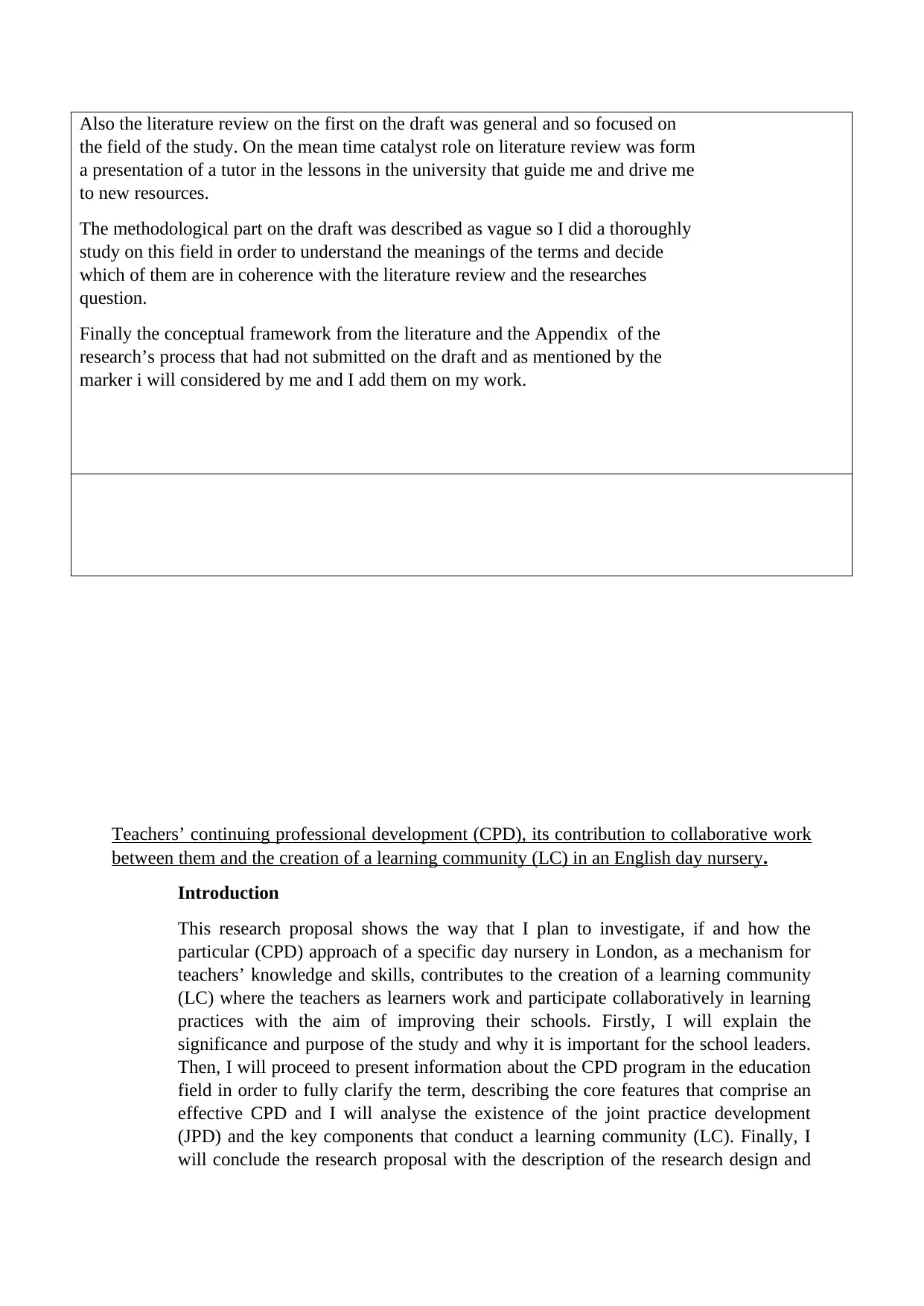
Also the literature review on the first on the draft was general and so focused on
the field of the study. On the mean time catalyst role on literature review was form
a presentation of a tutor in the lessons in the university that guide me and drive me
to new resources.
The methodological part on the draft was described as vague so I did a thoroughly
study on this field in order to understand the meanings of the terms and decide
which of them are in coherence with the literature review and the researches
question.
Finally the conceptual framework from the literature and the Appendix of the
research’s process that had not submitted on the draft and as mentioned by the
marker i will considered by me and I add them on my work.
Teachers’ continuing professional development (CPD), its contribution to collaborative work
between them and the creation of a learning community (LC) in an English day nursery.
Introduction
This research proposal shows the way that I plan to investigate, if and how the
particular (CPD) approach of a specific day nursery in London, as a mechanism for
teachers’ knowledge and skills, contributes to the creation of a learning community
(LC) where the teachers as learners work and participate collaboratively in learning
practices with the aim of improving their schools. Firstly, I will explain the
significance and purpose of the study and why it is important for the school leaders.
Then, I will proceed to present information about the CPD program in the education
field in order to fully clarify the term, describing the core features that comprise an
effective CPD and I will analyse the existence of the joint practice development
(JPD) and the key components that conduct a learning community (LC). Finally, I
will conclude the research proposal with the description of the research design and
the field of the study. On the mean time catalyst role on literature review was form
a presentation of a tutor in the lessons in the university that guide me and drive me
to new resources.
The methodological part on the draft was described as vague so I did a thoroughly
study on this field in order to understand the meanings of the terms and decide
which of them are in coherence with the literature review and the researches
question.
Finally the conceptual framework from the literature and the Appendix of the
research’s process that had not submitted on the draft and as mentioned by the
marker i will considered by me and I add them on my work.
Teachers’ continuing professional development (CPD), its contribution to collaborative work
between them and the creation of a learning community (LC) in an English day nursery.
Introduction
This research proposal shows the way that I plan to investigate, if and how the
particular (CPD) approach of a specific day nursery in London, as a mechanism for
teachers’ knowledge and skills, contributes to the creation of a learning community
(LC) where the teachers as learners work and participate collaboratively in learning
practices with the aim of improving their schools. Firstly, I will explain the
significance and purpose of the study and why it is important for the school leaders.
Then, I will proceed to present information about the CPD program in the education
field in order to fully clarify the term, describing the core features that comprise an
effective CPD and I will analyse the existence of the joint practice development
(JPD) and the key components that conduct a learning community (LC). Finally, I
will conclude the research proposal with the description of the research design and
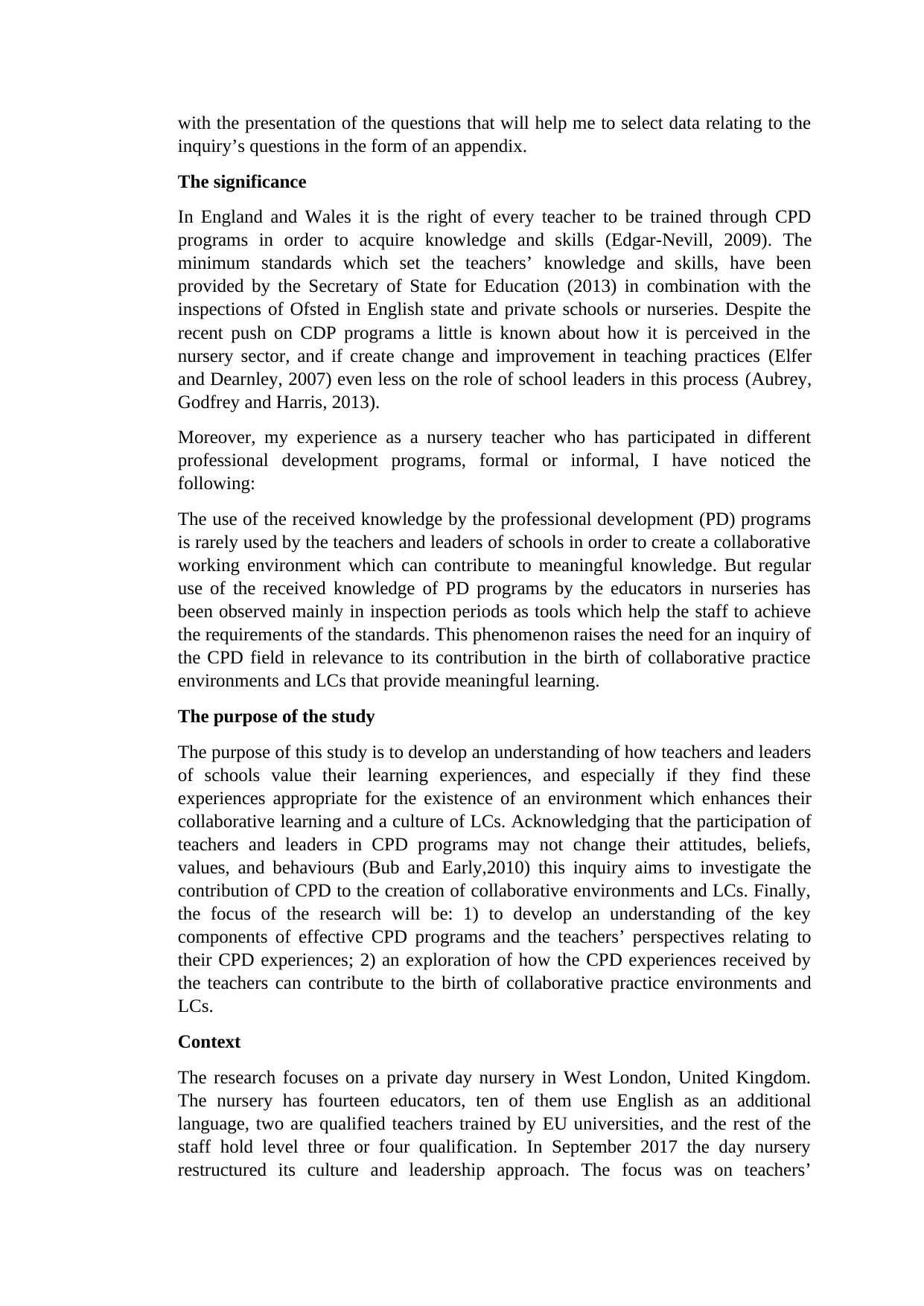
with the presentation of the questions that will help me to select data relating to the
inquiry’s questions in the form of an appendix.
The significance
In England and Wales it is the right of every teacher to be trained through CPD
programs in order to acquire knowledge and skills (Edgar-Nevill, 2009). The
minimum standards which set the teachers’ knowledge and skills, have been
provided by the Secretary of State for Education (2013) in combination with the
inspections of Ofsted in English state and private schools or nurseries. Despite the
recent push on CDP programs a little is known about how it is perceived in the
nursery sector, and if create change and improvement in teaching practices (Elfer
and Dearnley, 2007) even less on the role of school leaders in this process (Aubrey,
Godfrey and Harris, 2013).
Moreover, my experience as a nursery teacher who has participated in different
professional development programs, formal or informal, I have noticed the
following:
The use of the received knowledge by the professional development (PD) programs
is rarely used by the teachers and leaders of schools in order to create a collaborative
working environment which can contribute to meaningful knowledge. But regular
use of the received knowledge of PD programs by the educators in nurseries has
been observed mainly in inspection periods as tools which help the staff to achieve
the requirements of the standards. This phenomenon raises the need for an inquiry of
the CPD field in relevance to its contribution in the birth of collaborative practice
environments and LCs that provide meaningful learning.
The purpose of the study
The purpose of this study is to develop an understanding of how teachers and leaders
of schools value their learning experiences, and especially if they find these
experiences appropriate for the existence of an environment which enhances their
collaborative learning and a culture of LCs. Acknowledging that the participation of
teachers and leaders in CPD programs may not change their attitudes, beliefs,
values, and behaviours (Bub and Early,2010) this inquiry aims to investigate the
contribution of CPD to the creation of collaborative environments and LCs. Finally,
the focus of the research will be: 1) to develop an understanding of the key
components of effective CPD programs and the teachers’ perspectives relating to
their CPD experiences; 2) an exploration of how the CPD experiences received by
the teachers can contribute to the birth of collaborative practice environments and
LCs.
Context
The research focuses on a private day nursery in West London, United Kingdom.
The nursery has fourteen educators, ten of them use English as an additional
language, two are qualified teachers trained by EU universities, and the rest of the
staff hold level three or four qualification. In September 2017 the day nursery
restructured its culture and leadership approach. The focus was on teachers’
inquiry’s questions in the form of an appendix.
The significance
In England and Wales it is the right of every teacher to be trained through CPD
programs in order to acquire knowledge and skills (Edgar-Nevill, 2009). The
minimum standards which set the teachers’ knowledge and skills, have been
provided by the Secretary of State for Education (2013) in combination with the
inspections of Ofsted in English state and private schools or nurseries. Despite the
recent push on CDP programs a little is known about how it is perceived in the
nursery sector, and if create change and improvement in teaching practices (Elfer
and Dearnley, 2007) even less on the role of school leaders in this process (Aubrey,
Godfrey and Harris, 2013).
Moreover, my experience as a nursery teacher who has participated in different
professional development programs, formal or informal, I have noticed the
following:
The use of the received knowledge by the professional development (PD) programs
is rarely used by the teachers and leaders of schools in order to create a collaborative
working environment which can contribute to meaningful knowledge. But regular
use of the received knowledge of PD programs by the educators in nurseries has
been observed mainly in inspection periods as tools which help the staff to achieve
the requirements of the standards. This phenomenon raises the need for an inquiry of
the CPD field in relevance to its contribution in the birth of collaborative practice
environments and LCs that provide meaningful learning.
The purpose of the study
The purpose of this study is to develop an understanding of how teachers and leaders
of schools value their learning experiences, and especially if they find these
experiences appropriate for the existence of an environment which enhances their
collaborative learning and a culture of LCs. Acknowledging that the participation of
teachers and leaders in CPD programs may not change their attitudes, beliefs,
values, and behaviours (Bub and Early,2010) this inquiry aims to investigate the
contribution of CPD to the creation of collaborative environments and LCs. Finally,
the focus of the research will be: 1) to develop an understanding of the key
components of effective CPD programs and the teachers’ perspectives relating to
their CPD experiences; 2) an exploration of how the CPD experiences received by
the teachers can contribute to the birth of collaborative practice environments and
LCs.
Context
The research focuses on a private day nursery in West London, United Kingdom.
The nursery has fourteen educators, ten of them use English as an additional
language, two are qualified teachers trained by EU universities, and the rest of the
staff hold level three or four qualification. In September 2017 the day nursery
restructured its culture and leadership approach. The focus was on teachers’
⊘ This is a preview!⊘
Do you want full access?
Subscribe today to unlock all pages.

Trusted by 1+ million students worldwide
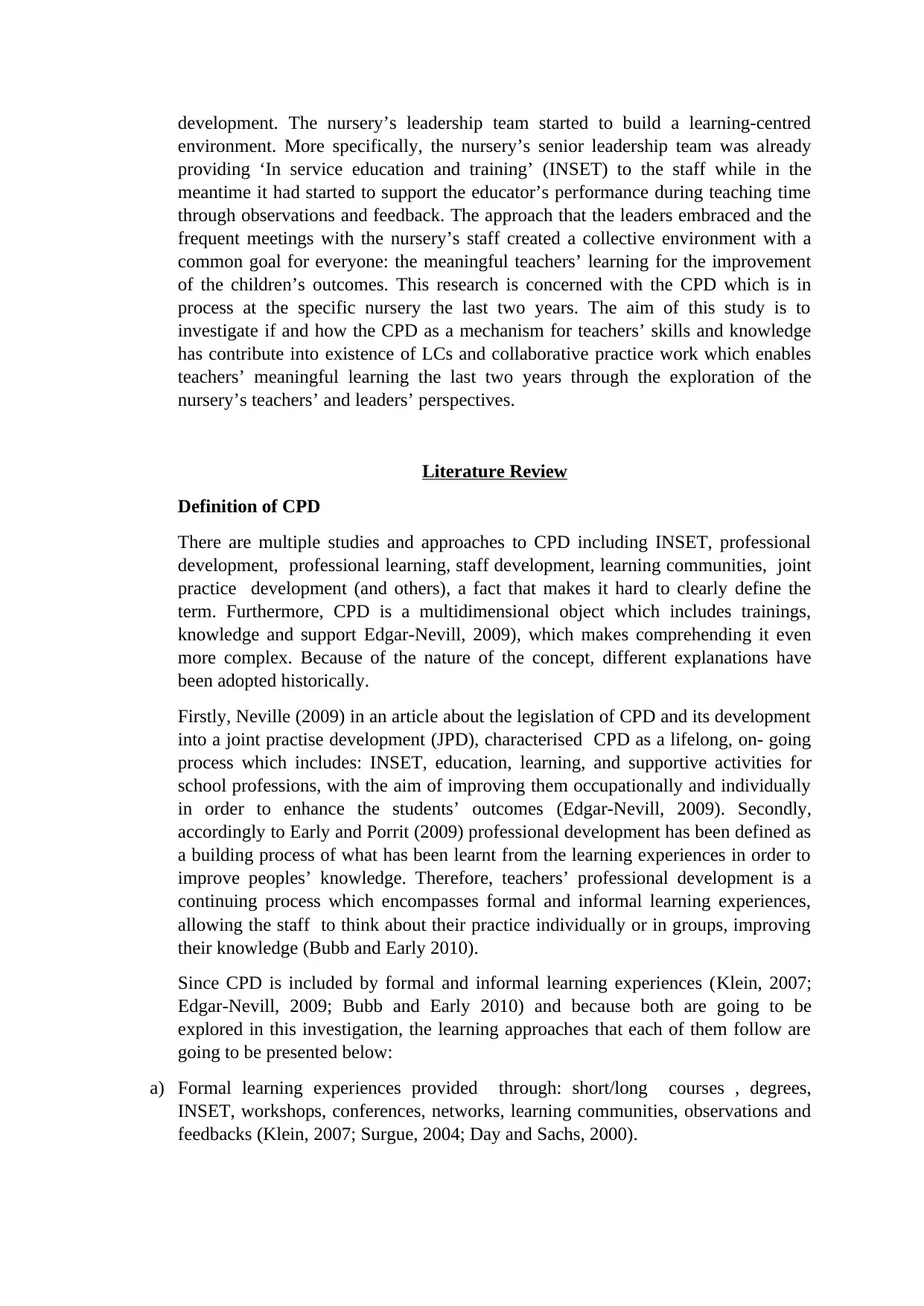
development. The nursery’s leadership team started to build a learning-centred
environment. More specifically, the nursery’s senior leadership team was already
providing ‘In service education and training’ (INSET) to the staff while in the
meantime it had started to support the educator’s performance during teaching time
through observations and feedback. The approach that the leaders embraced and the
frequent meetings with the nursery’s staff created a collective environment with a
common goal for everyone: the meaningful teachers’ learning for the improvement
of the children’s outcomes. This research is concerned with the CPD which is in
process at the specific nursery the last two years. The aim of this study is to
investigate if and how the CPD as a mechanism for teachers’ skills and knowledge
has contribute into existence of LCs and collaborative practice work which enables
teachers’ meaningful learning the last two years through the exploration of the
nursery’s teachers’ and leaders’ perspectives.
Literature Review
Definition of CPD
There are multiple studies and approaches to CPD including INSET, professional
development, professional learning, staff development, learning communities, joint
practice development (and others), a fact that makes it hard to clearly define the
term. Furthermore, CPD is a multidimensional object which includes trainings,
knowledge and support Edgar-Nevill, 2009), which makes comprehending it even
more complex. Because of the nature of the concept, different explanations have
been adopted historically.
Firstly, Neville (2009) in an article about the legislation of CPD and its development
into a joint practise development (JPD), characterised CPD as a lifelong, on- going
process which includes: INSET, education, learning, and supportive activities for
school professions, with the aim of improving them occupationally and individually
in order to enhance the students’ outcomes (Edgar-Nevill, 2009). Secondly,
accordingly to Early and Porrit (2009) professional development has been defined as
a building process of what has been learnt from the learning experiences in order to
improve peoples’ knowledge. Therefore, teachers’ professional development is a
continuing process which encompasses formal and informal learning experiences,
allowing the staff to think about their practice individually or in groups, improving
their knowledge (Bubb and Early 2010).
Since CPD is included by formal and informal learning experiences (Klein, 2007;
Edgar-Nevill, 2009; Bubb and Early 2010) and because both are going to be
explored in this investigation, the learning approaches that each of them follow are
going to be presented below:
a) Formal learning experiences provided through: short/long courses , degrees,
INSET, workshops, conferences, networks, learning communities, observations and
feedbacks (Klein, 2007; Surgue, 2004; Day and Sachs, 2000).
environment. More specifically, the nursery’s senior leadership team was already
providing ‘In service education and training’ (INSET) to the staff while in the
meantime it had started to support the educator’s performance during teaching time
through observations and feedback. The approach that the leaders embraced and the
frequent meetings with the nursery’s staff created a collective environment with a
common goal for everyone: the meaningful teachers’ learning for the improvement
of the children’s outcomes. This research is concerned with the CPD which is in
process at the specific nursery the last two years. The aim of this study is to
investigate if and how the CPD as a mechanism for teachers’ skills and knowledge
has contribute into existence of LCs and collaborative practice work which enables
teachers’ meaningful learning the last two years through the exploration of the
nursery’s teachers’ and leaders’ perspectives.
Literature Review
Definition of CPD
There are multiple studies and approaches to CPD including INSET, professional
development, professional learning, staff development, learning communities, joint
practice development (and others), a fact that makes it hard to clearly define the
term. Furthermore, CPD is a multidimensional object which includes trainings,
knowledge and support Edgar-Nevill, 2009), which makes comprehending it even
more complex. Because of the nature of the concept, different explanations have
been adopted historically.
Firstly, Neville (2009) in an article about the legislation of CPD and its development
into a joint practise development (JPD), characterised CPD as a lifelong, on- going
process which includes: INSET, education, learning, and supportive activities for
school professions, with the aim of improving them occupationally and individually
in order to enhance the students’ outcomes (Edgar-Nevill, 2009). Secondly,
accordingly to Early and Porrit (2009) professional development has been defined as
a building process of what has been learnt from the learning experiences in order to
improve peoples’ knowledge. Therefore, teachers’ professional development is a
continuing process which encompasses formal and informal learning experiences,
allowing the staff to think about their practice individually or in groups, improving
their knowledge (Bubb and Early 2010).
Since CPD is included by formal and informal learning experiences (Klein, 2007;
Edgar-Nevill, 2009; Bubb and Early 2010) and because both are going to be
explored in this investigation, the learning approaches that each of them follow are
going to be presented below:
a) Formal learning experiences provided through: short/long courses , degrees,
INSET, workshops, conferences, networks, learning communities, observations and
feedbacks (Klein, 2007; Surgue, 2004; Day and Sachs, 2000).
Paraphrase This Document
Need a fresh take? Get an instant paraphrase of this document with our AI Paraphraser

b) Informal learning experiences provided through: Individual private course,
staffroom conversations (Kennedy, 2011), occasional lectures, journals, magazines
and videos (Day and Sachs, 2004).
In conclusion, the fundamental objective of CPD is to develop teachers’
professionalism in order for the teachers to later contribute to the improvement
students’ outcomes (Klein, 2007; Bubb and Early 2010).
In the next section I will define what effective CPD is and provide an analysis of its
core features.
Definition of effective CPD & core features for its effectiveness.
Early and Bubb (2007) defined the effective CPD as an object which includes the
most important component for improving peoples’ outcomes, while simultaneously
supporting the changes in practice and improving teaching (Bub and Early, 2007).
Effective professional development has been defined as a planned method for
teachers’ learning which aims to improve teachers’ practices and students’ outcomes
(Darling-Hammond et al, 2017). However, as mentioned earlier the complex nature
of CPD which includes different needs and purposes (Muijs et al, 2004) makes their
transfer into change in schools and classrooms difficult to do (Darling-Hammond,
Hyler and Gardner, 2017). Drawing from the arguments of different authors, it is
possible to identify eight core features of effective CPD: 1) focus on content , 2)
active learning, 3) supportive collaboration, 4) models of effective practice , 5)
sustained duration (Darling-Hammond, 2017), 6) coaching and support, 7)
provision of advice through feedback and reflection and 8) coherence
An analysis of the eight features of CPD is going to be provided below:
1) Content focused methodology provides learning based on the context of the
teacher’s classroom and includes teaching strategies based on specific subjects of the
school curriculum.
2) Active learning moves away from passive ways of learning and focuses on
interactive practices as peer-to-peer observations and teachers’ engagement in the
designing of teaching strategies.
3) Supportive collaboration is the process where people work and learn together to
achieve shared aims through dialogues, shared practices, peer-to-peer observations
and reflective activities (Mourshed et al., 2010).
4) Models of effective practice included by JPD (Stoll, Harris and Handscomb, 2012),
peer-to-peer observation and study lessons
5) Sustained duration defined by the hours which CPD activities take up and the period
of time which the activities span. (Robinson, 2014)
6) Coaching and support provided by content evidence-based practices to the teachers
and are specific to the individual needs of teachers ( Knight 2002)
7) Feedback and reflection are processes which help teachers to think about what they
do in their classes, assess it and apply changes to improve their practice
8) Coherence is defined as a dimension of CPD which embeds the teacher’s learning
according to his/her beliefs and the school’s needs
staffroom conversations (Kennedy, 2011), occasional lectures, journals, magazines
and videos (Day and Sachs, 2004).
In conclusion, the fundamental objective of CPD is to develop teachers’
professionalism in order for the teachers to later contribute to the improvement
students’ outcomes (Klein, 2007; Bubb and Early 2010).
In the next section I will define what effective CPD is and provide an analysis of its
core features.
Definition of effective CPD & core features for its effectiveness.
Early and Bubb (2007) defined the effective CPD as an object which includes the
most important component for improving peoples’ outcomes, while simultaneously
supporting the changes in practice and improving teaching (Bub and Early, 2007).
Effective professional development has been defined as a planned method for
teachers’ learning which aims to improve teachers’ practices and students’ outcomes
(Darling-Hammond et al, 2017). However, as mentioned earlier the complex nature
of CPD which includes different needs and purposes (Muijs et al, 2004) makes their
transfer into change in schools and classrooms difficult to do (Darling-Hammond,
Hyler and Gardner, 2017). Drawing from the arguments of different authors, it is
possible to identify eight core features of effective CPD: 1) focus on content , 2)
active learning, 3) supportive collaboration, 4) models of effective practice , 5)
sustained duration (Darling-Hammond, 2017), 6) coaching and support, 7)
provision of advice through feedback and reflection and 8) coherence
An analysis of the eight features of CPD is going to be provided below:
1) Content focused methodology provides learning based on the context of the
teacher’s classroom and includes teaching strategies based on specific subjects of the
school curriculum.
2) Active learning moves away from passive ways of learning and focuses on
interactive practices as peer-to-peer observations and teachers’ engagement in the
designing of teaching strategies.
3) Supportive collaboration is the process where people work and learn together to
achieve shared aims through dialogues, shared practices, peer-to-peer observations
and reflective activities (Mourshed et al., 2010).
4) Models of effective practice included by JPD (Stoll, Harris and Handscomb, 2012),
peer-to-peer observation and study lessons
5) Sustained duration defined by the hours which CPD activities take up and the period
of time which the activities span. (Robinson, 2014)
6) Coaching and support provided by content evidence-based practices to the teachers
and are specific to the individual needs of teachers ( Knight 2002)
7) Feedback and reflection are processes which help teachers to think about what they
do in their classes, assess it and apply changes to improve their practice
8) Coherence is defined as a dimension of CPD which embeds the teacher’s learning
according to his/her beliefs and the school’s needs
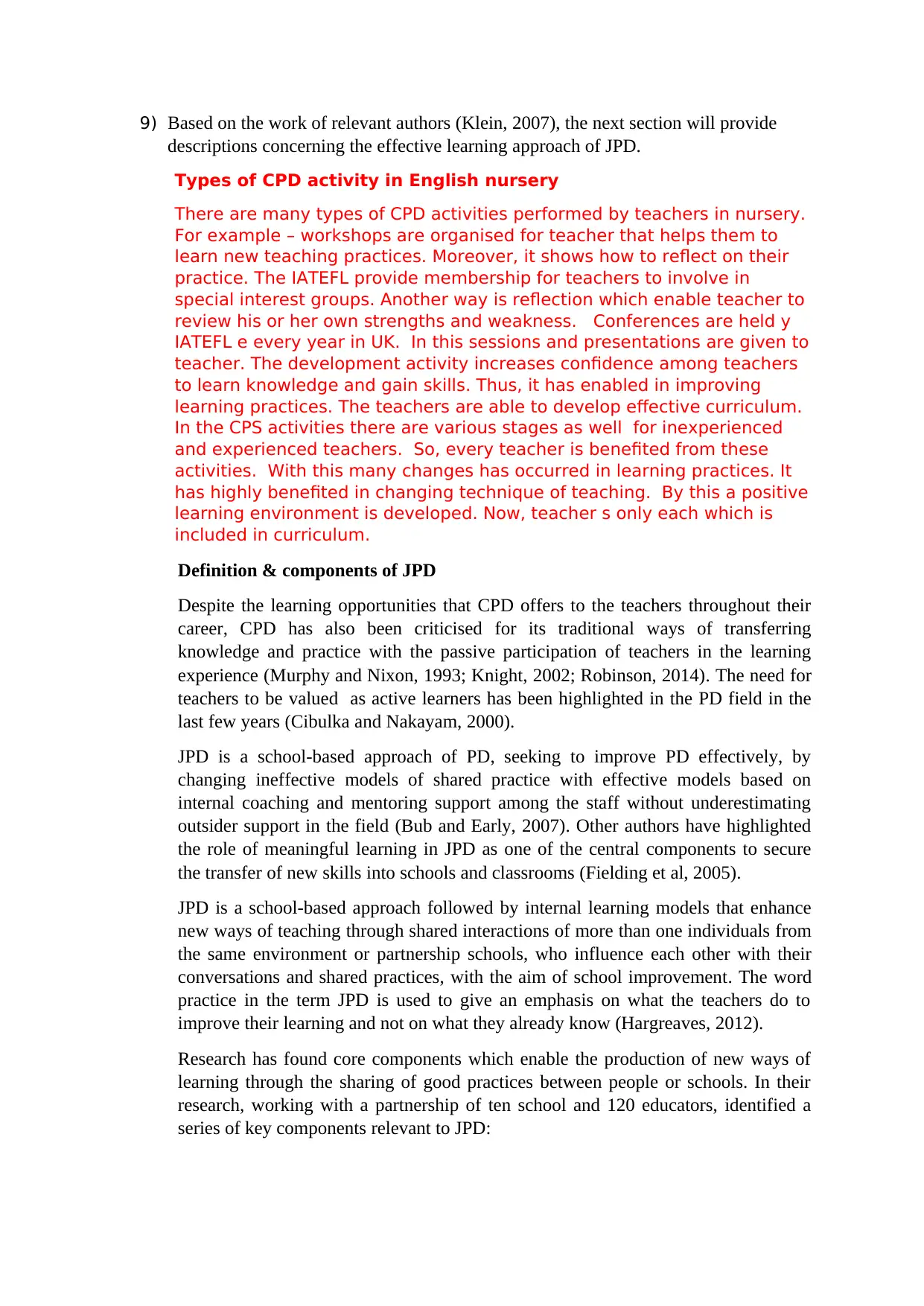
9) Based on the work of relevant authors (Klein, 2007), the next section will provide
descriptions concerning the effective learning approach of JPD.
Types of CPD activity in English nursery
There are many types of CPD activities performed by teachers in nursery.
For example – workshops are organised for teacher that helps them to
learn new teaching practices. Moreover, it shows how to reflect on their
practice. The IATEFL provide membership for teachers to involve in
special interest groups. Another way is reflection which enable teacher to
review his or her own strengths and weakness. Conferences are held y
IATEFL e every year in UK. In this sessions and presentations are given to
teacher. The development activity increases confidence among teachers
to learn knowledge and gain skills. Thus, it has enabled in improving
learning practices. The teachers are able to develop effective curriculum.
In the CPS activities there are various stages as well for inexperienced
and experienced teachers. So, every teacher is benefited from these
activities. With this many changes has occurred in learning practices. It
has highly benefited in changing technique of teaching. By this a positive
learning environment is developed. Now, teacher s only each which is
included in curriculum.
Definition & components of JPD
Despite the learning opportunities that CPD offers to the teachers throughout their
career, CPD has also been criticised for its traditional ways of transferring
knowledge and practice with the passive participation of teachers in the learning
experience (Murphy and Nixon, 1993; Knight, 2002; Robinson, 2014). The need for
teachers to be valued as active learners has been highlighted in the PD field in the
last few years (Cibulka and Nakayam, 2000).
JPD is a school-based approach of PD, seeking to improve PD effectively, by
changing ineffective models of shared practice with effective models based on
internal coaching and mentoring support among the staff without underestimating
outsider support in the field (Bub and Early, 2007). Other authors have highlighted
the role of meaningful learning in JPD as one of the central components to secure
the transfer of new skills into schools and classrooms (Fielding et al, 2005).
JPD is a school-based approach followed by internal learning models that enhance
new ways of teaching through shared interactions of more than one individuals from
the same environment or partnership schools, who influence each other with their
conversations and shared practices, with the aim of school improvement. The word
practice in the term JPD is used to give an emphasis on what the teachers do to
improve their learning and not on what they already know (Hargreaves, 2012).
Research has found core components which enable the production of new ways of
learning through the sharing of good practices between people or schools. In their
research, working with a partnership of ten school and 120 educators, identified a
series of key components relevant to JPD:
descriptions concerning the effective learning approach of JPD.
Types of CPD activity in English nursery
There are many types of CPD activities performed by teachers in nursery.
For example – workshops are organised for teacher that helps them to
learn new teaching practices. Moreover, it shows how to reflect on their
practice. The IATEFL provide membership for teachers to involve in
special interest groups. Another way is reflection which enable teacher to
review his or her own strengths and weakness. Conferences are held y
IATEFL e every year in UK. In this sessions and presentations are given to
teacher. The development activity increases confidence among teachers
to learn knowledge and gain skills. Thus, it has enabled in improving
learning practices. The teachers are able to develop effective curriculum.
In the CPS activities there are various stages as well for inexperienced
and experienced teachers. So, every teacher is benefited from these
activities. With this many changes has occurred in learning practices. It
has highly benefited in changing technique of teaching. By this a positive
learning environment is developed. Now, teacher s only each which is
included in curriculum.
Definition & components of JPD
Despite the learning opportunities that CPD offers to the teachers throughout their
career, CPD has also been criticised for its traditional ways of transferring
knowledge and practice with the passive participation of teachers in the learning
experience (Murphy and Nixon, 1993; Knight, 2002; Robinson, 2014). The need for
teachers to be valued as active learners has been highlighted in the PD field in the
last few years (Cibulka and Nakayam, 2000).
JPD is a school-based approach of PD, seeking to improve PD effectively, by
changing ineffective models of shared practice with effective models based on
internal coaching and mentoring support among the staff without underestimating
outsider support in the field (Bub and Early, 2007). Other authors have highlighted
the role of meaningful learning in JPD as one of the central components to secure
the transfer of new skills into schools and classrooms (Fielding et al, 2005).
JPD is a school-based approach followed by internal learning models that enhance
new ways of teaching through shared interactions of more than one individuals from
the same environment or partnership schools, who influence each other with their
conversations and shared practices, with the aim of school improvement. The word
practice in the term JPD is used to give an emphasis on what the teachers do to
improve their learning and not on what they already know (Hargreaves, 2012).
Research has found core components which enable the production of new ways of
learning through the sharing of good practices between people or schools. In their
research, working with a partnership of ten school and 120 educators, identified a
series of key components relevant to JPD:
⊘ This is a preview!⊘
Do you want full access?
Subscribe today to unlock all pages.

Trusted by 1+ million students worldwide
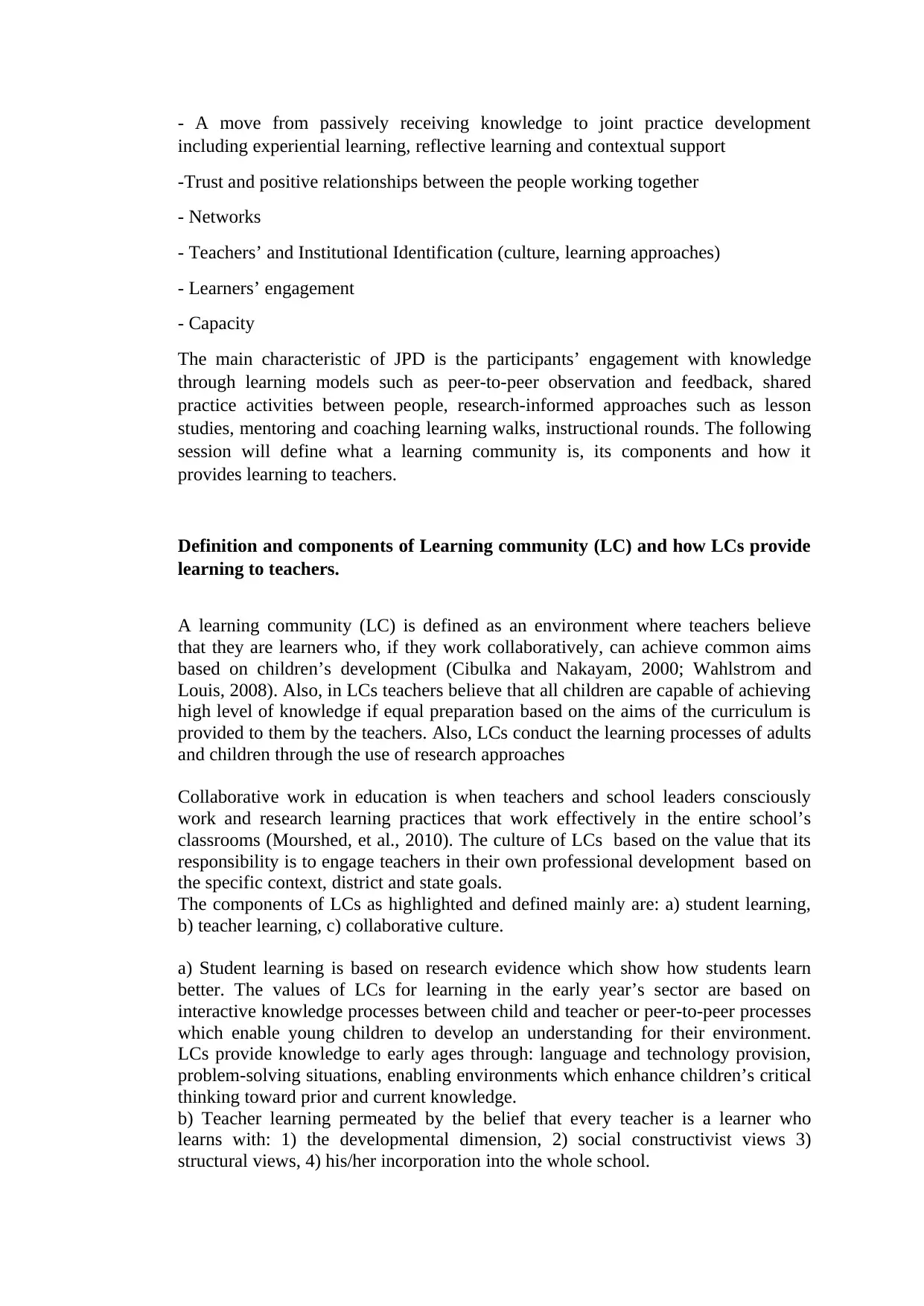
- A move from passively receiving knowledge to joint practice development
including experiential learning, reflective learning and contextual support
-Trust and positive relationships between the people working together
- Networks
- Teachers’ and Institutional Identification (culture, learning approaches)
- Learners’ engagement
- Capacity
The main characteristic of JPD is the participants’ engagement with knowledge
through learning models such as peer-to-peer observation and feedback, shared
practice activities between people, research-informed approaches such as lesson
studies, mentoring and coaching learning walks, instructional rounds. The following
session will define what a learning community is, its components and how it
provides learning to teachers.
Definition and components of Learning community (LC) and how LCs provide
learning to teachers.
A learning community (LC) is defined as an environment where teachers believe
that they are learners who, if they work collaboratively, can achieve common aims
based on children’s development (Cibulka and Nakayam, 2000; Wahlstrom and
Louis, 2008). Also, in LCs teachers believe that all children are capable of achieving
high level of knowledge if equal preparation based on the aims of the curriculum is
provided to them by the teachers. Also, LCs conduct the learning processes of adults
and children through the use of research approaches
Collaborative work in education is when teachers and school leaders consciously
work and research learning practices that work effectively in the entire school’s
classrooms (Mourshed, et al., 2010). The culture of LCs based on the value that its
responsibility is to engage teachers in their own professional development based on
the specific context, district and state goals.
The components of LCs as highlighted and defined mainly are: a) student learning,
b) teacher learning, c) collaborative culture.
a) Student learning is based on research evidence which show how students learn
better. The values of LCs for learning in the early year’s sector are based on
interactive knowledge processes between child and teacher or peer-to-peer processes
which enable young children to develop an understanding for their environment.
LCs provide knowledge to early ages through: language and technology provision,
problem-solving situations, enabling environments which enhance children’s critical
thinking toward prior and current knowledge.
b) Teacher learning permeated by the belief that every teacher is a learner who
learns with: 1) the developmental dimension, 2) social constructivist views 3)
structural views, 4) his/her incorporation into the whole school.
including experiential learning, reflective learning and contextual support
-Trust and positive relationships between the people working together
- Networks
- Teachers’ and Institutional Identification (culture, learning approaches)
- Learners’ engagement
- Capacity
The main characteristic of JPD is the participants’ engagement with knowledge
through learning models such as peer-to-peer observation and feedback, shared
practice activities between people, research-informed approaches such as lesson
studies, mentoring and coaching learning walks, instructional rounds. The following
session will define what a learning community is, its components and how it
provides learning to teachers.
Definition and components of Learning community (LC) and how LCs provide
learning to teachers.
A learning community (LC) is defined as an environment where teachers believe
that they are learners who, if they work collaboratively, can achieve common aims
based on children’s development (Cibulka and Nakayam, 2000; Wahlstrom and
Louis, 2008). Also, in LCs teachers believe that all children are capable of achieving
high level of knowledge if equal preparation based on the aims of the curriculum is
provided to them by the teachers. Also, LCs conduct the learning processes of adults
and children through the use of research approaches
Collaborative work in education is when teachers and school leaders consciously
work and research learning practices that work effectively in the entire school’s
classrooms (Mourshed, et al., 2010). The culture of LCs based on the value that its
responsibility is to engage teachers in their own professional development based on
the specific context, district and state goals.
The components of LCs as highlighted and defined mainly are: a) student learning,
b) teacher learning, c) collaborative culture.
a) Student learning is based on research evidence which show how students learn
better. The values of LCs for learning in the early year’s sector are based on
interactive knowledge processes between child and teacher or peer-to-peer processes
which enable young children to develop an understanding for their environment.
LCs provide knowledge to early ages through: language and technology provision,
problem-solving situations, enabling environments which enhance children’s critical
thinking toward prior and current knowledge.
b) Teacher learning permeated by the belief that every teacher is a learner who
learns with: 1) the developmental dimension, 2) social constructivist views 3)
structural views, 4) his/her incorporation into the whole school.
Paraphrase This Document
Need a fresh take? Get an instant paraphrase of this document with our AI Paraphraser
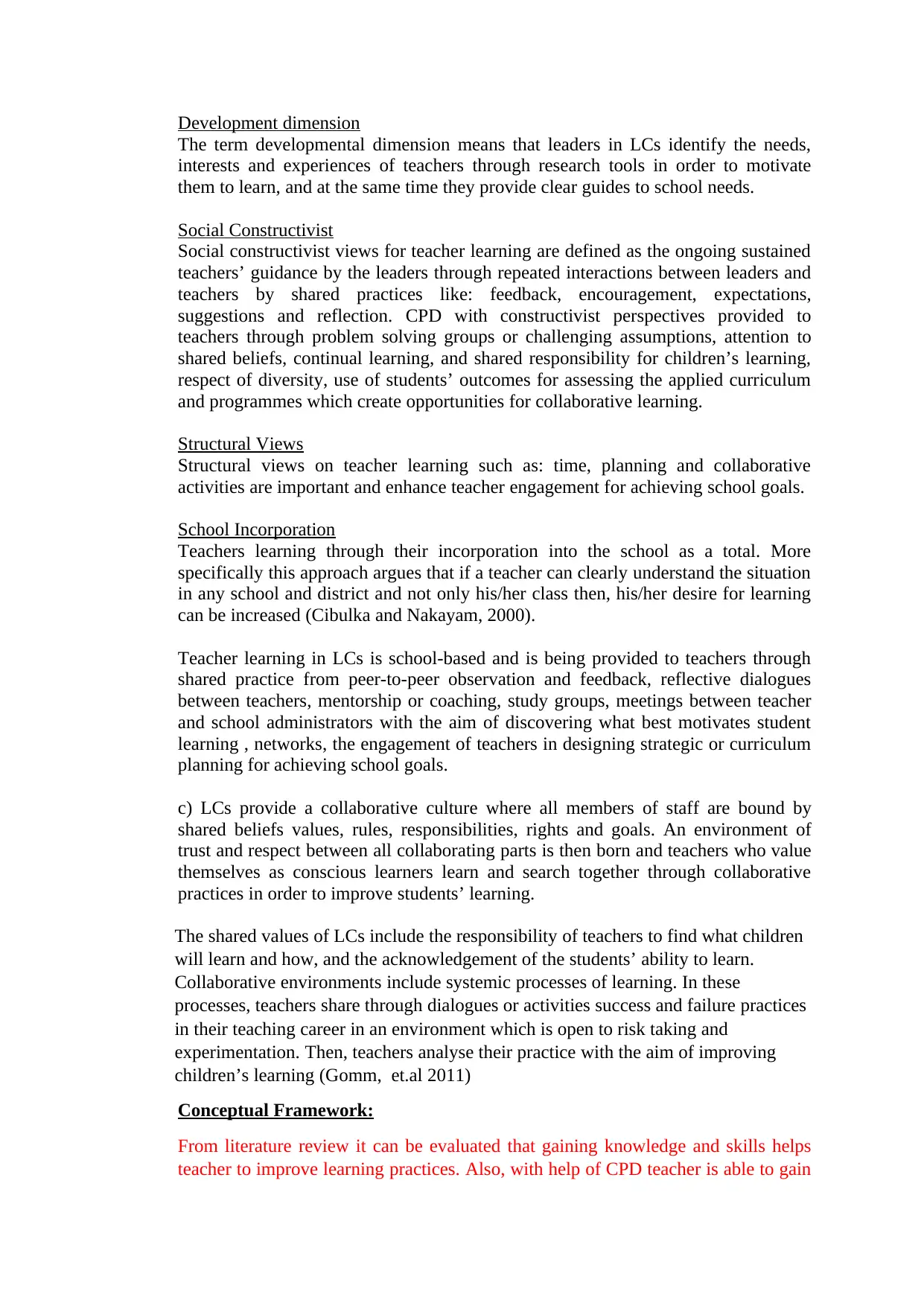
Development dimension
The term developmental dimension means that leaders in LCs identify the needs,
interests and experiences of teachers through research tools in order to motivate
them to learn, and at the same time they provide clear guides to school needs.
Social Constructivist
Social constructivist views for teacher learning are defined as the ongoing sustained
teachers’ guidance by the leaders through repeated interactions between leaders and
teachers by shared practices like: feedback, encouragement, expectations,
suggestions and reflection. CPD with constructivist perspectives provided to
teachers through problem solving groups or challenging assumptions, attention to
shared beliefs, continual learning, and shared responsibility for children’s learning,
respect of diversity, use of students’ outcomes for assessing the applied curriculum
and programmes which create opportunities for collaborative learning.
Structural Views
Structural views on teacher learning such as: time, planning and collaborative
activities are important and enhance teacher engagement for achieving school goals.
School Incorporation
Teachers learning through their incorporation into the school as a total. More
specifically this approach argues that if a teacher can clearly understand the situation
in any school and district and not only his/her class then, his/her desire for learning
can be increased (Cibulka and Nakayam, 2000).
Teacher learning in LCs is school-based and is being provided to teachers through
shared practice from peer-to-peer observation and feedback, reflective dialogues
between teachers, mentorship or coaching, study groups, meetings between teacher
and school administrators with the aim of discovering what best motivates student
learning , networks, the engagement of teachers in designing strategic or curriculum
planning for achieving school goals.
c) LCs provide a collaborative culture where all members of staff are bound by
shared beliefs values, rules, responsibilities, rights and goals. An environment of
trust and respect between all collaborating parts is then born and teachers who value
themselves as conscious learners learn and search together through collaborative
practices in order to improve students’ learning.
The shared values of LCs include the responsibility of teachers to find what children
will learn and how, and the acknowledgement of the students’ ability to learn.
Collaborative environments include systemic processes of learning. In these
processes, teachers share through dialogues or activities success and failure practices
in their teaching career in an environment which is open to risk taking and
experimentation. Then, teachers analyse their practice with the aim of improving
children’s learning (Gomm, et.al 2011)
Conceptual Framework:
From literature review it can be evaluated that gaining knowledge and skills helps
teacher to improve learning practices. Also, with help of CPD teacher is able to gain
The term developmental dimension means that leaders in LCs identify the needs,
interests and experiences of teachers through research tools in order to motivate
them to learn, and at the same time they provide clear guides to school needs.
Social Constructivist
Social constructivist views for teacher learning are defined as the ongoing sustained
teachers’ guidance by the leaders through repeated interactions between leaders and
teachers by shared practices like: feedback, encouragement, expectations,
suggestions and reflection. CPD with constructivist perspectives provided to
teachers through problem solving groups or challenging assumptions, attention to
shared beliefs, continual learning, and shared responsibility for children’s learning,
respect of diversity, use of students’ outcomes for assessing the applied curriculum
and programmes which create opportunities for collaborative learning.
Structural Views
Structural views on teacher learning such as: time, planning and collaborative
activities are important and enhance teacher engagement for achieving school goals.
School Incorporation
Teachers learning through their incorporation into the school as a total. More
specifically this approach argues that if a teacher can clearly understand the situation
in any school and district and not only his/her class then, his/her desire for learning
can be increased (Cibulka and Nakayam, 2000).
Teacher learning in LCs is school-based and is being provided to teachers through
shared practice from peer-to-peer observation and feedback, reflective dialogues
between teachers, mentorship or coaching, study groups, meetings between teacher
and school administrators with the aim of discovering what best motivates student
learning , networks, the engagement of teachers in designing strategic or curriculum
planning for achieving school goals.
c) LCs provide a collaborative culture where all members of staff are bound by
shared beliefs values, rules, responsibilities, rights and goals. An environment of
trust and respect between all collaborating parts is then born and teachers who value
themselves as conscious learners learn and search together through collaborative
practices in order to improve students’ learning.
The shared values of LCs include the responsibility of teachers to find what children
will learn and how, and the acknowledgement of the students’ ability to learn.
Collaborative environments include systemic processes of learning. In these
processes, teachers share through dialogues or activities success and failure practices
in their teaching career in an environment which is open to risk taking and
experimentation. Then, teachers analyse their practice with the aim of improving
children’s learning (Gomm, et.al 2011)
Conceptual Framework:
From literature review it can be evaluated that gaining knowledge and skills helps
teacher to improve learning practices. Also, with help of CPD teacher is able to gain
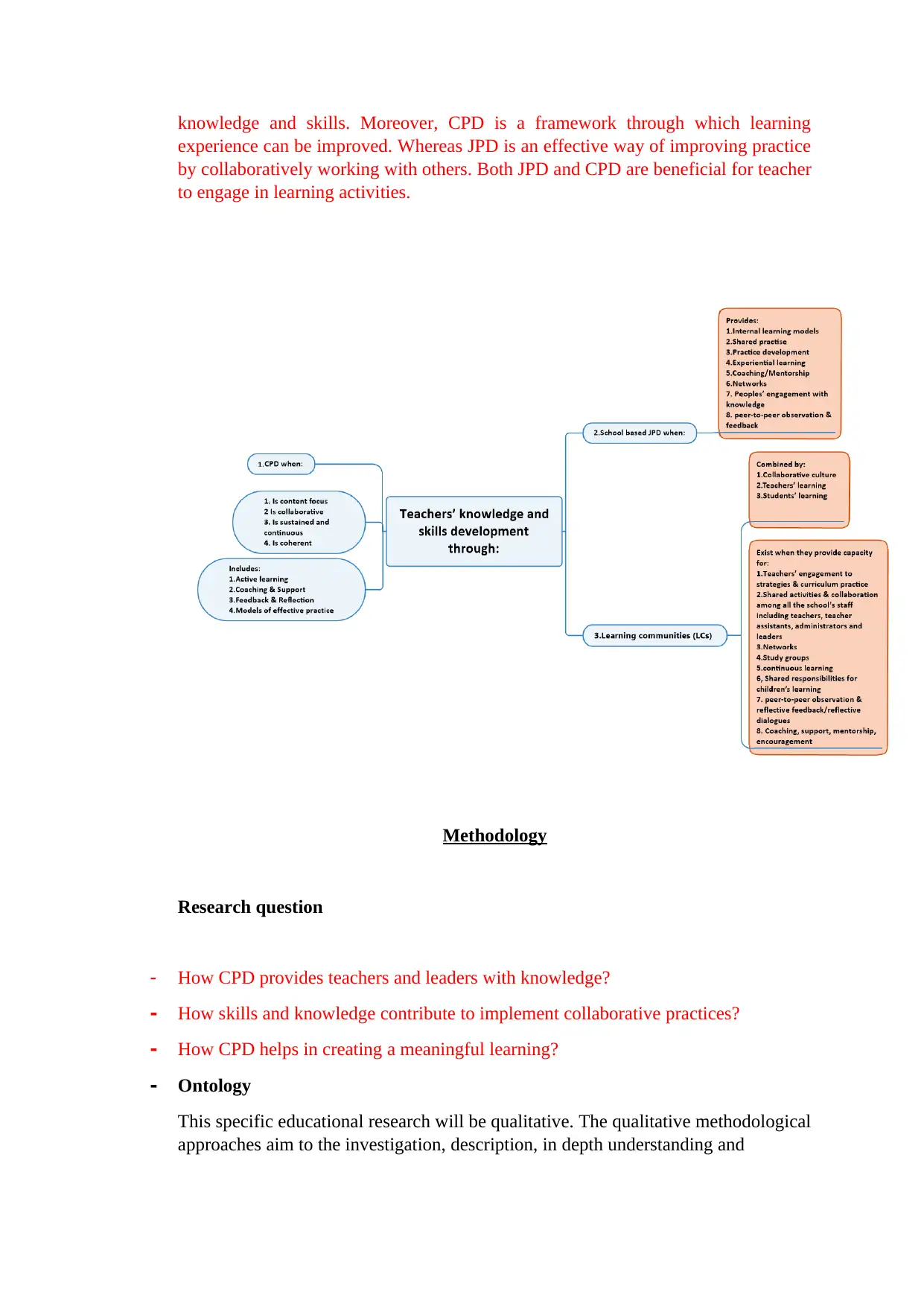
knowledge and skills. Moreover, CPD is a framework through which learning
experience can be improved. Whereas JPD is an effective way of improving practice
by collaboratively working with others. Both JPD and CPD are beneficial for teacher
to engage in learning activities.
Methodology
Research question
- How CPD provides teachers and leaders with knowledge?
- How skills and knowledge contribute to implement collaborative practices?
- How CPD helps in creating a meaningful learning?
- Ontology
This specific educational research will be qualitative. The qualitative methodological
approaches aim to the investigation, description, in depth understanding and
experience can be improved. Whereas JPD is an effective way of improving practice
by collaboratively working with others. Both JPD and CPD are beneficial for teacher
to engage in learning activities.
Methodology
Research question
- How CPD provides teachers and leaders with knowledge?
- How skills and knowledge contribute to implement collaborative practices?
- How CPD helps in creating a meaningful learning?
- Ontology
This specific educational research will be qualitative. The qualitative methodological
approaches aim to the investigation, description, in depth understanding and
⊘ This is a preview!⊘
Do you want full access?
Subscribe today to unlock all pages.

Trusted by 1+ million students worldwide
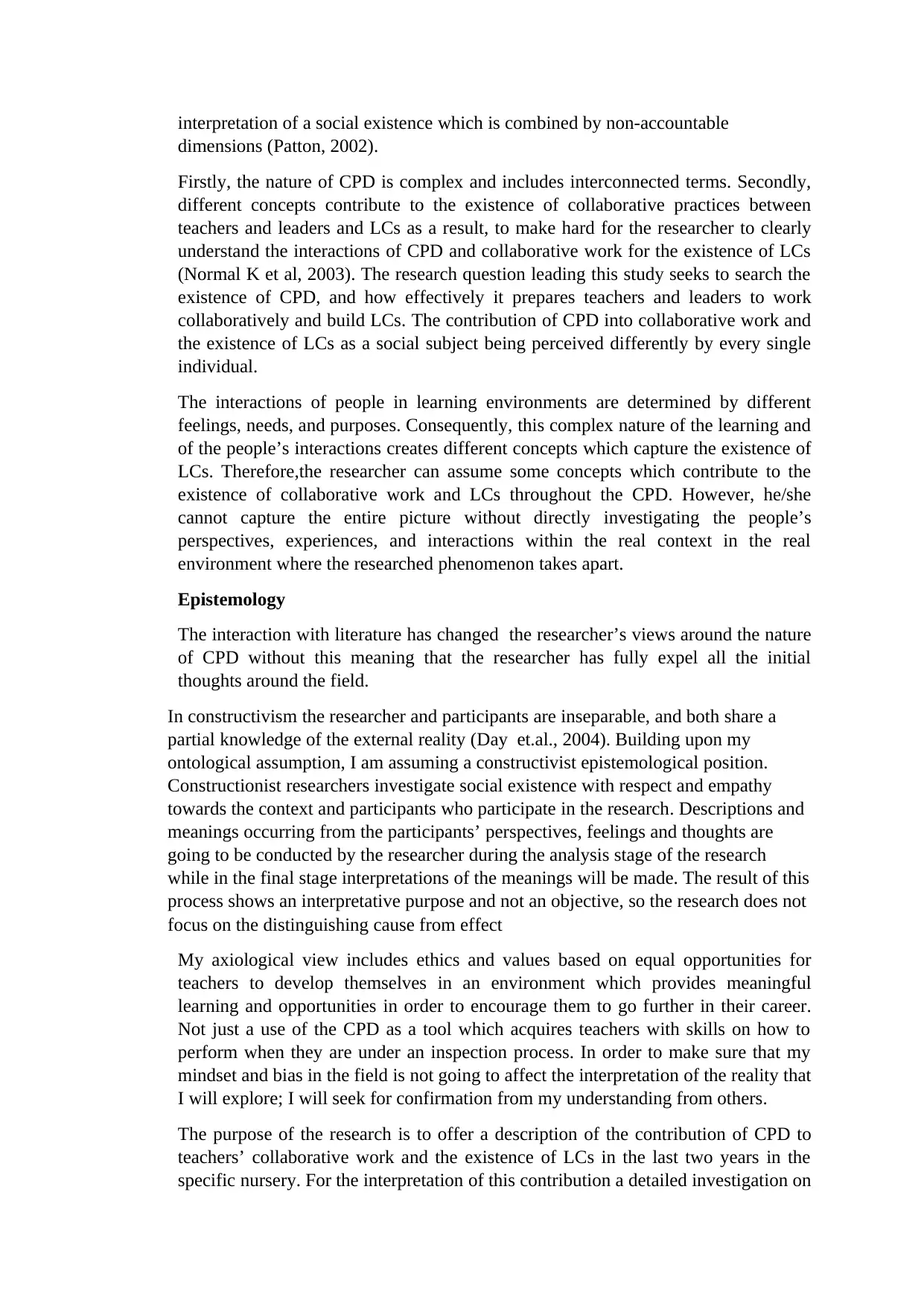
interpretation of a social existence which is combined by non-accountable
dimensions (Patton, 2002).
Firstly, the nature of CPD is complex and includes interconnected terms. Secondly,
different concepts contribute to the existence of collaborative practices between
teachers and leaders and LCs as a result, to make hard for the researcher to clearly
understand the interactions of CPD and collaborative work for the existence of LCs
(Normal K et al, 2003). The research question leading this study seeks to search the
existence of CPD, and how effectively it prepares teachers and leaders to work
collaboratively and build LCs. The contribution of CPD into collaborative work and
the existence of LCs as a social subject being perceived differently by every single
individual.
The interactions of people in learning environments are determined by different
feelings, needs, and purposes. Consequently, this complex nature of the learning and
of the people’s interactions creates different concepts which capture the existence of
LCs. Therefore,the researcher can assume some concepts which contribute to the
existence of collaborative work and LCs throughout the CPD. However, he/she
cannot capture the entire picture without directly investigating the people’s
perspectives, experiences, and interactions within the real context in the real
environment where the researched phenomenon takes apart.
Epistemology
The interaction with literature has changed the researcher’s views around the nature
of CPD without this meaning that the researcher has fully expel all the initial
thoughts around the field.
In constructivism the researcher and participants are inseparable, and both share a
partial knowledge of the external reality (Day et.al., 2004). Building upon my
ontological assumption, I am assuming a constructivist epistemological position.
Constructionist researchers investigate social existence with respect and empathy
towards the context and participants who participate in the research. Descriptions and
meanings occurring from the participants’ perspectives, feelings and thoughts are
going to be conducted by the researcher during the analysis stage of the research
while in the final stage interpretations of the meanings will be made. The result of this
process shows an interpretative purpose and not an objective, so the research does not
focus on the distinguishing cause from effect
My axiological view includes ethics and values based on equal opportunities for
teachers to develop themselves in an environment which provides meaningful
learning and opportunities in order to encourage them to go further in their career.
Not just a use of the CPD as a tool which acquires teachers with skills on how to
perform when they are under an inspection process. In order to make sure that my
mindset and bias in the field is not going to affect the interpretation of the reality that
I will explore; I will seek for confirmation from my understanding from others.
The purpose of the research is to offer a description of the contribution of CPD to
teachers’ collaborative work and the existence of LCs in the last two years in the
specific nursery. For the interpretation of this contribution a detailed investigation on
dimensions (Patton, 2002).
Firstly, the nature of CPD is complex and includes interconnected terms. Secondly,
different concepts contribute to the existence of collaborative practices between
teachers and leaders and LCs as a result, to make hard for the researcher to clearly
understand the interactions of CPD and collaborative work for the existence of LCs
(Normal K et al, 2003). The research question leading this study seeks to search the
existence of CPD, and how effectively it prepares teachers and leaders to work
collaboratively and build LCs. The contribution of CPD into collaborative work and
the existence of LCs as a social subject being perceived differently by every single
individual.
The interactions of people in learning environments are determined by different
feelings, needs, and purposes. Consequently, this complex nature of the learning and
of the people’s interactions creates different concepts which capture the existence of
LCs. Therefore,the researcher can assume some concepts which contribute to the
existence of collaborative work and LCs throughout the CPD. However, he/she
cannot capture the entire picture without directly investigating the people’s
perspectives, experiences, and interactions within the real context in the real
environment where the researched phenomenon takes apart.
Epistemology
The interaction with literature has changed the researcher’s views around the nature
of CPD without this meaning that the researcher has fully expel all the initial
thoughts around the field.
In constructivism the researcher and participants are inseparable, and both share a
partial knowledge of the external reality (Day et.al., 2004). Building upon my
ontological assumption, I am assuming a constructivist epistemological position.
Constructionist researchers investigate social existence with respect and empathy
towards the context and participants who participate in the research. Descriptions and
meanings occurring from the participants’ perspectives, feelings and thoughts are
going to be conducted by the researcher during the analysis stage of the research
while in the final stage interpretations of the meanings will be made. The result of this
process shows an interpretative purpose and not an objective, so the research does not
focus on the distinguishing cause from effect
My axiological view includes ethics and values based on equal opportunities for
teachers to develop themselves in an environment which provides meaningful
learning and opportunities in order to encourage them to go further in their career.
Not just a use of the CPD as a tool which acquires teachers with skills on how to
perform when they are under an inspection process. In order to make sure that my
mindset and bias in the field is not going to affect the interpretation of the reality that
I will explore; I will seek for confirmation from my understanding from others.
The purpose of the research is to offer a description of the contribution of CPD to
teachers’ collaborative work and the existence of LCs in the last two years in the
specific nursery. For the interpretation of this contribution a detailed investigation on
Paraphrase This Document
Need a fresh take? Get an instant paraphrase of this document with our AI Paraphraser

a small number of participants needs to take place in the specific nursery where the
CPD has taken place.
Finally, in order for the researcher to capture the contribution of CPD to
collaborative work and to the existence of LCs, he/she will analyse in detail the
perspectives and experiences that are held by the small number of participants from
the environment where the CPD takes place. Consequently, the investigation will be
in depth but on a small scale with few participants and specific contexts, and as a
result any generalisation of the findings
Research Design
I am proposing a case study design. A case study is not a method but a study of the
complexities that are presented in a specific case which the researcher has been
interested in for a period of time. The purpose of a single case study is to understand
the nature of the case and its interactions with the context within which the case
exists (Stake, 1995).
This empirical inquiry will have the form of an intrinsic single case study because of
its purpose to explore the nature of CPD and of learning environments and to capture
and describe how CPD can prepare teachers in order to create collaborative practices
and LCs. The subject of the research will be CPD as a mechanism which provides
knowledge and skills to teachers, and the object is how teachers and leaders have
been trained through CPD in the last two years in the specific nursery in order to
become capable of creating sustained internal collaborative practices and LCs.
Finally, it will be descriptive because the researcher will seek emic meanings that
have occurred by the people within the context (Stake, 2003). Accordingly, the
research will take place in the environment that the CPD exists.
Data Collection
Interview
An interview is a process which is employed in qualitative researches and allows
researchers to discover whatever they cannot directly observe, such as feelings,
thoughts or perceptions. The aim of an interview is to allow the researcher to get into
the interviewer’s perspectives concerning the phenomenon which is under research.
Also, interviews provide flexibility to the researcher to follow the discourse of each
participant. The most common types of qualitative interviews are: semi-structured
interviews, informal conversations and group interviews (Lin, 2016). In this research
interviews will be used by the researcher as techniques for data collection and
analysis for an in-depth understanding (Oliver, 2004.). The interviews will include
open-ended questions which are based on themes that occur from studies in the field
and the research question.
The design of the semi-structured interview will include open-ended questions based
on the research question (see Appendix, 1).
During the interview the researcher will follow the themes’ contents and will be able
to skip or rephrase a question when appropriate. Semi-structured interviews allow
CPD has taken place.
Finally, in order for the researcher to capture the contribution of CPD to
collaborative work and to the existence of LCs, he/she will analyse in detail the
perspectives and experiences that are held by the small number of participants from
the environment where the CPD takes place. Consequently, the investigation will be
in depth but on a small scale with few participants and specific contexts, and as a
result any generalisation of the findings
Research Design
I am proposing a case study design. A case study is not a method but a study of the
complexities that are presented in a specific case which the researcher has been
interested in for a period of time. The purpose of a single case study is to understand
the nature of the case and its interactions with the context within which the case
exists (Stake, 1995).
This empirical inquiry will have the form of an intrinsic single case study because of
its purpose to explore the nature of CPD and of learning environments and to capture
and describe how CPD can prepare teachers in order to create collaborative practices
and LCs. The subject of the research will be CPD as a mechanism which provides
knowledge and skills to teachers, and the object is how teachers and leaders have
been trained through CPD in the last two years in the specific nursery in order to
become capable of creating sustained internal collaborative practices and LCs.
Finally, it will be descriptive because the researcher will seek emic meanings that
have occurred by the people within the context (Stake, 2003). Accordingly, the
research will take place in the environment that the CPD exists.
Data Collection
Interview
An interview is a process which is employed in qualitative researches and allows
researchers to discover whatever they cannot directly observe, such as feelings,
thoughts or perceptions. The aim of an interview is to allow the researcher to get into
the interviewer’s perspectives concerning the phenomenon which is under research.
Also, interviews provide flexibility to the researcher to follow the discourse of each
participant. The most common types of qualitative interviews are: semi-structured
interviews, informal conversations and group interviews (Lin, 2016). In this research
interviews will be used by the researcher as techniques for data collection and
analysis for an in-depth understanding (Oliver, 2004.). The interviews will include
open-ended questions which are based on themes that occur from studies in the field
and the research question.
The design of the semi-structured interview will include open-ended questions based
on the research question (see Appendix, 1).
During the interview the researcher will follow the themes’ contents and will be able
to skip or rephrase a question when appropriate. Semi-structured interviews allow
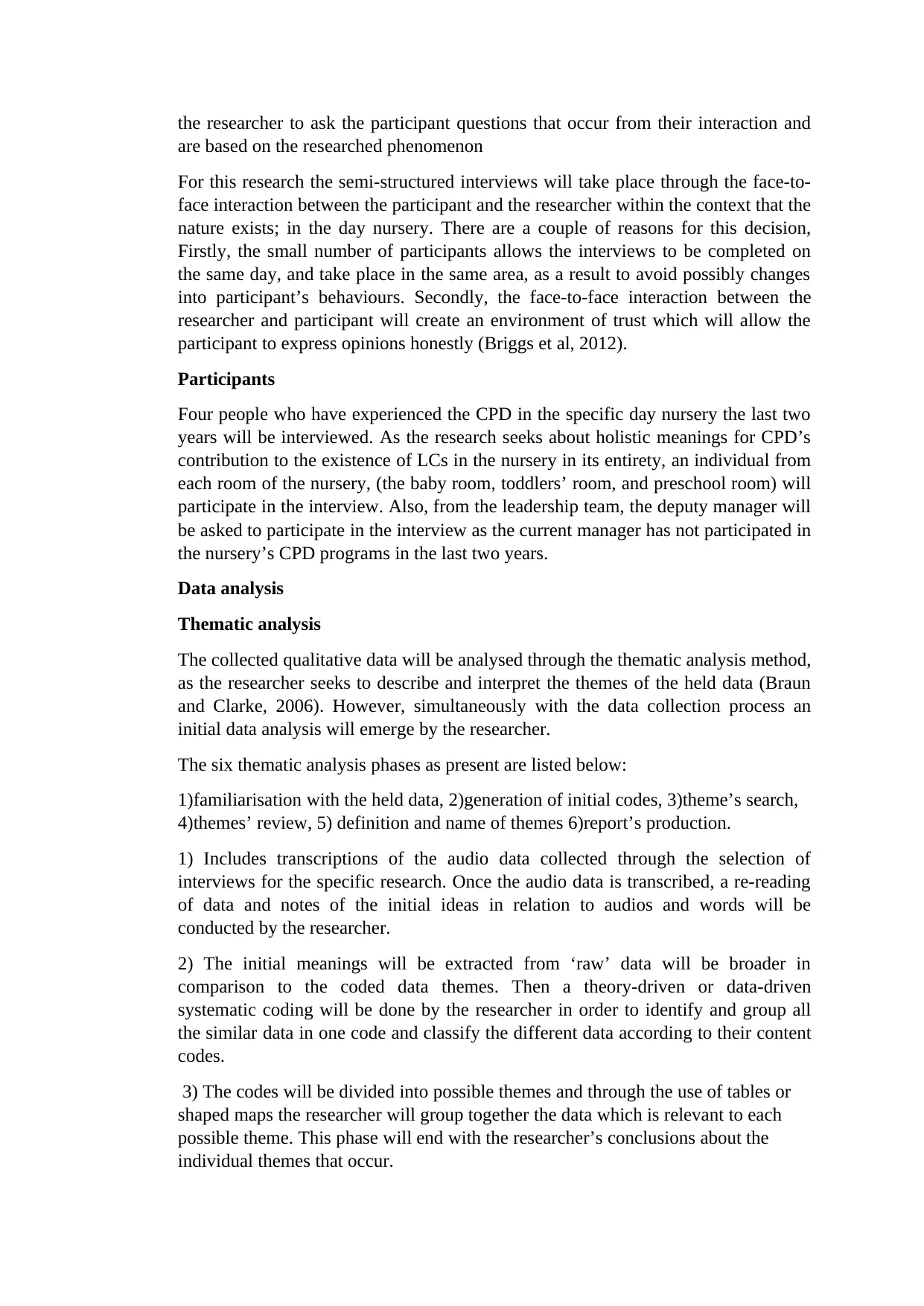
the researcher to ask the participant questions that occur from their interaction and
are based on the researched phenomenon
For this research the semi-structured interviews will take place through the face-to-
face interaction between the participant and the researcher within the context that the
nature exists; in the day nursery. There are a couple of reasons for this decision,
Firstly, the small number of participants allows the interviews to be completed on
the same day, and take place in the same area, as a result to avoid possibly changes
into participant’s behaviours. Secondly, the face-to-face interaction between the
researcher and participant will create an environment of trust which will allow the
participant to express opinions honestly (Briggs et al, 2012).
Participants
Four people who have experienced the CPD in the specific day nursery the last two
years will be interviewed. As the research seeks about holistic meanings for CPD’s
contribution to the existence of LCs in the nursery in its entirety, an individual from
each room of the nursery, (the baby room, toddlers’ room, and preschool room) will
participate in the interview. Also, from the leadership team, the deputy manager will
be asked to participate in the interview as the current manager has not participated in
the nursery’s CPD programs in the last two years.
Data analysis
Thematic analysis
The collected qualitative data will be analysed through the thematic analysis method,
as the researcher seeks to describe and interpret the themes of the held data (Braun
and Clarke, 2006). However, simultaneously with the data collection process an
initial data analysis will emerge by the researcher.
The six thematic analysis phases as present are listed below:
1)familiarisation with the held data, 2)generation of initial codes, 3)theme’s search,
4)themes’ review, 5) definition and name of themes 6)report’s production.
1) Includes transcriptions of the audio data collected through the selection of
interviews for the specific research. Once the audio data is transcribed, a re-reading
of data and notes of the initial ideas in relation to audios and words will be
conducted by the researcher.
2) The initial meanings will be extracted from ‘raw’ data will be broader in
comparison to the coded data themes. Then a theory-driven or data-driven
systematic coding will be done by the researcher in order to identify and group all
the similar data in one code and classify the different data according to their content
codes.
3) The codes will be divided into possible themes and through the use of tables or
shaped maps the researcher will group together the data which is relevant to each
possible theme. This phase will end with the researcher’s conclusions about the
individual themes that occur.
are based on the researched phenomenon
For this research the semi-structured interviews will take place through the face-to-
face interaction between the participant and the researcher within the context that the
nature exists; in the day nursery. There are a couple of reasons for this decision,
Firstly, the small number of participants allows the interviews to be completed on
the same day, and take place in the same area, as a result to avoid possibly changes
into participant’s behaviours. Secondly, the face-to-face interaction between the
researcher and participant will create an environment of trust which will allow the
participant to express opinions honestly (Briggs et al, 2012).
Participants
Four people who have experienced the CPD in the specific day nursery the last two
years will be interviewed. As the research seeks about holistic meanings for CPD’s
contribution to the existence of LCs in the nursery in its entirety, an individual from
each room of the nursery, (the baby room, toddlers’ room, and preschool room) will
participate in the interview. Also, from the leadership team, the deputy manager will
be asked to participate in the interview as the current manager has not participated in
the nursery’s CPD programs in the last two years.
Data analysis
Thematic analysis
The collected qualitative data will be analysed through the thematic analysis method,
as the researcher seeks to describe and interpret the themes of the held data (Braun
and Clarke, 2006). However, simultaneously with the data collection process an
initial data analysis will emerge by the researcher.
The six thematic analysis phases as present are listed below:
1)familiarisation with the held data, 2)generation of initial codes, 3)theme’s search,
4)themes’ review, 5) definition and name of themes 6)report’s production.
1) Includes transcriptions of the audio data collected through the selection of
interviews for the specific research. Once the audio data is transcribed, a re-reading
of data and notes of the initial ideas in relation to audios and words will be
conducted by the researcher.
2) The initial meanings will be extracted from ‘raw’ data will be broader in
comparison to the coded data themes. Then a theory-driven or data-driven
systematic coding will be done by the researcher in order to identify and group all
the similar data in one code and classify the different data according to their content
codes.
3) The codes will be divided into possible themes and through the use of tables or
shaped maps the researcher will group together the data which is relevant to each
possible theme. This phase will end with the researcher’s conclusions about the
individual themes that occur.
⊘ This is a preview!⊘
Do you want full access?
Subscribe today to unlock all pages.

Trusted by 1+ million students worldwide
1 out of 17
Related Documents
Your All-in-One AI-Powered Toolkit for Academic Success.
+13062052269
info@desklib.com
Available 24*7 on WhatsApp / Email
![[object Object]](/_next/static/media/star-bottom.7253800d.svg)
Unlock your academic potential
Copyright © 2020–2025 A2Z Services. All Rights Reserved. Developed and managed by ZUCOL.





